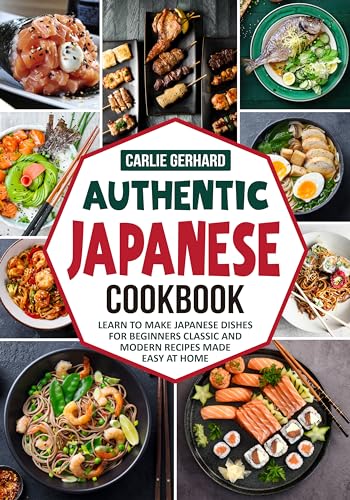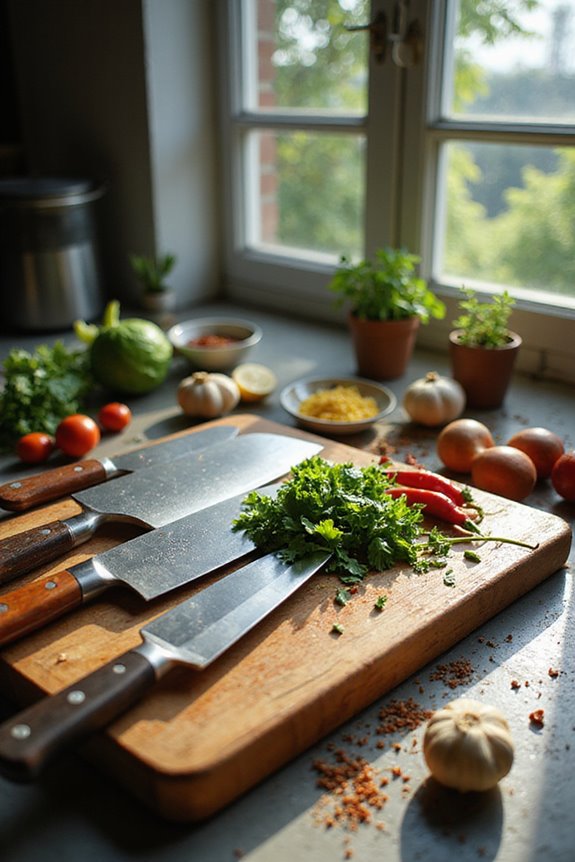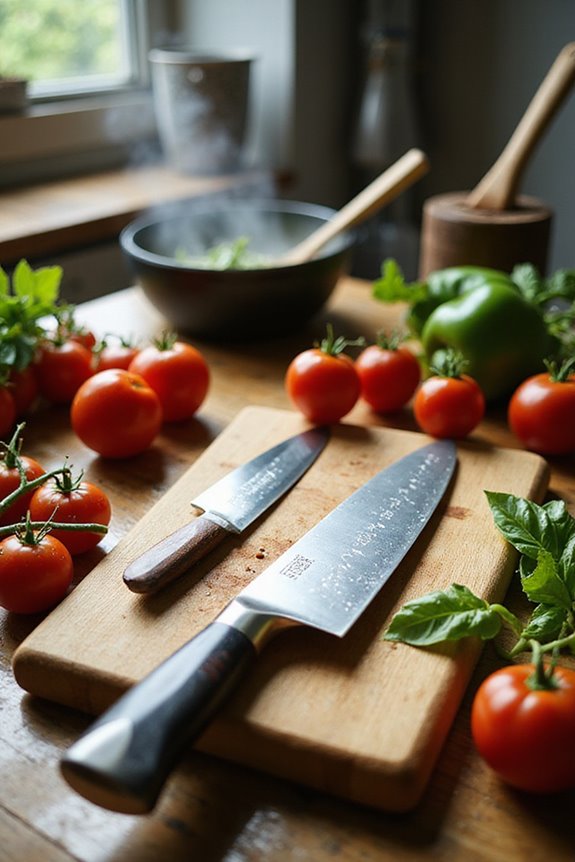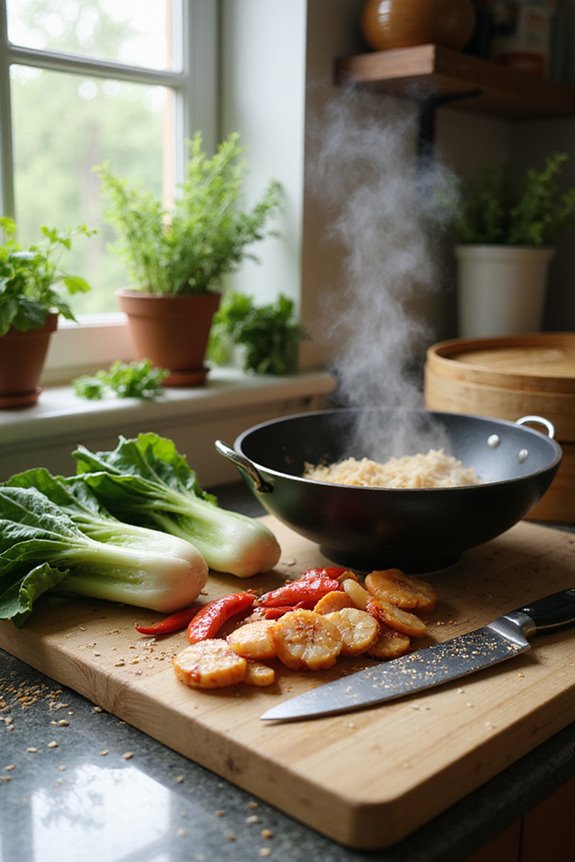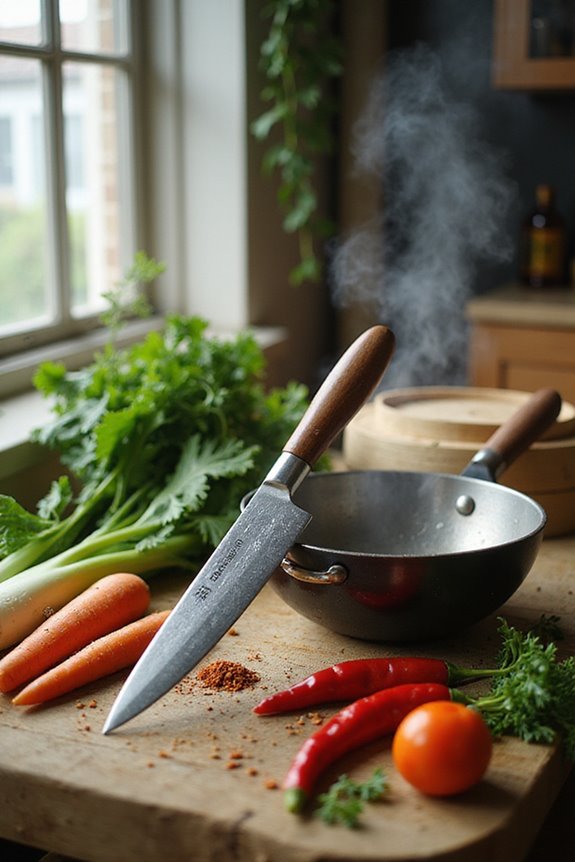As an Amazon Associate, we earn from qualifying purchases. Some links may be affiliate links at no extra cost to you. Although our opinions are based on curated research, we haven't used these products. Articles generated with AI.
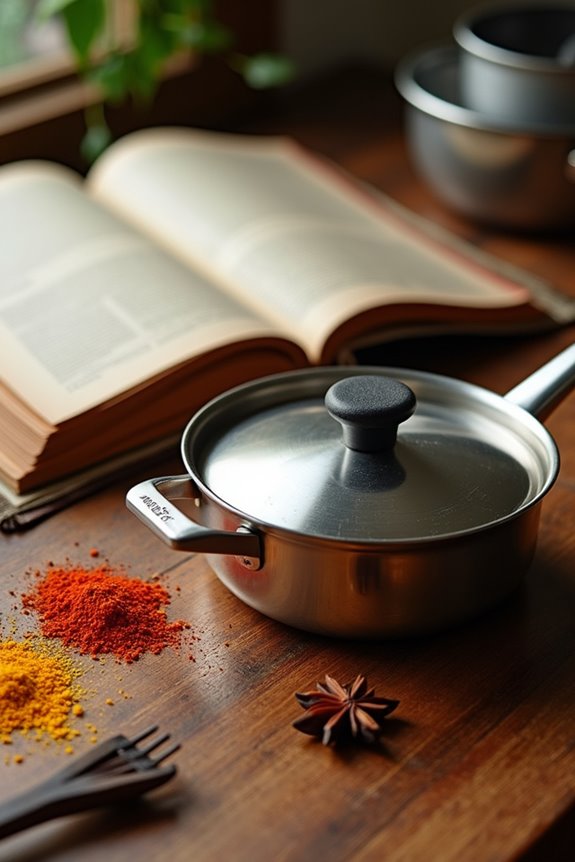
5 Best Japanese Cookbooks for Authentic Recipes You Need to Try
If you’re looking to explore authentic Japanese cuisine, consider these five cookbooks: “Japanese Soul Cooking” for izakaya favorites, “Japanese Cooking Made Simple” for clear instructions, “Japan: The Cookbook” for unique recipes, “Authentic Japanese Cookbook for Beginners” for simple dishes, and “Simply Japanese” for easy home cooking. Each offers a blend of culture, technique, and accessibility, making them perfect for cooks of any level. Keep going to find out more insights about these fantastic resources.
Key Takeaways
- Japanese Soul Cooking offers concise recipes for izakaya favorites, with alternatives for hard-to-find ingredients and cultural insights, perfect for various skill levels.
- Japanese Cooking Made Simple provides clear, step-by-step instructions on authentic recipes, focusing on essential techniques and flavor profiles, ideal for beginners.
- Japan: The Cookbook is a beautiful, comprehensive resource for experienced chefs, featuring unique recipes that encourage culinary creativity, though some may be complex.
- Authentic Japanese Cookbook for Beginners highlights very simple recipes with easily accessible ingredients, primarily focusing on ramen, making it perfect for novice cooks.
- Simply Japanese features 100 easy-to-follow recipes with appealing visuals and U.S. measurements, catering to all skill levels and enhancing the cooking experience.
Japanese Soul Cooking: A Cookbook
Sale
Japanese Soul Cooking: Ramen, Tonkatsu, Tempura, and More from the Streets and Kitchens of Tokyo and...
- Used Book in Good Condition
- Hardcover Book
- Ono, Tadashi (Author)
If you’re someone craving authentic Japanese cuisine but don’t have extensive cooking skills, “Japanese Soul Cooking: A Cookbook” is perfect for you. This cookbook focuses on popular izakaya dishes, featuring concise, one-page recipes accompanied by helpful photos. You’ll find a variety of traditional dishes, such as ramen, gyoza, and okonomiyaki. Each recipe uses basic Japanese ingredients, suggesting alternatives for harder-to-find items, allowing you to adapt recipes with local options. The step-by-step instructions make it easy to navigate, whether you’re a novice or skilled cook. Plus, cultural insights enhance your understanding of Japan’s culinary artistry and traditions.
Best For: Individuals interested in recreating authentic Japanese izakaya dishes at home, regardless of their cooking skills.
Pros:
- Diverse Recipe Selection: Offers a wide range of traditional Japanese dishes, catering to various tastes.
- User-Friendly: Step-by-step instructions and photos make the recipes accessible for both novices and experienced cooks.
- Cultural Insights: Provides valuable context about Japanese culinary traditions, enhancing the cooking experience.
Cons:
- Ingredient Availability: Some recipes may require specialty items that could be difficult to find.
- Measurement Units: Uses American measurement units, which may be challenging for those accustomed to metric measurements.
- Desire for Substitutes: Some readers wish for more substitute options for specific ingredients.
Japanese Cooking Made Simple: A Japanese Cookbook with Authentic Recipes
Sale
Japanese Cooking Made Simple: A Japanese Cookbook with Authentic Recipes for Ramen, Bento, Sushi &...
- Salinas Press (Author)
- English (Publication Language)
- 280 Pages - 04/29/2014 (Publication Date) - Callisto (Publisher)
“Japanese Cooking Made Simple: A Japanese Cookbook with Authentic Recipes” stands out as an ideal choice for beginner cooks enthusiastic to explore Japanese cuisine. This cookbook emphasizes a holistic approach, encouraging you to engage thoughtfully with your cooking process. It includes a variety of recipes like Pork Belly Ramen and Vegetable Tempura, all accompanied by clear, step-by-step instructions. You’ll learn essential techniques, such as cutting vegetables evenly and maintaining frying temperatures. While you might find some ingredients challenging to obtain, the author provides valuable insights into flavor profiles, making your culinary journey enjoyable and accessible.
Best For: Beginners looking to delve into Japanese cuisine and enhance their cooking skills with authentic recipes.
Pros:
- Offers clear, step-by-step instructions that make complex dishes approachable for novice cooks.
- Provides valuable insights into Japanese flavor profiles and essential cooking techniques.
- Features a variety of popular recipes, making it an exciting resource for exploring diverse Japanese dishes.
Cons:
- Some ingredients may be hard to find, depending on the reader’s location.
- Lack of guidance on meal pairings could leave readers unsure about creating complete meals.
- Cooking Japanese food can feel more involved compared to other cuisines, which might deter some beginners.
Japan: The Cookbook
Sale
Japan: The Cookbook
- Hardcover Book
- Nancy Singleton Hachisu (Author)
- English (Publication Language)
For serious chefs and enthusiasts of Japanese cuisine, “Japan: The Cookbook” stands out as an essential resource. This beautifully crafted hardcover features a bamboo-like cover and stunning visuals, enhancing both its usability and kitchen decor. You’ll find a wealth of unique, authentic recipes that inspire creativity and adaptability in ingredient selection. While some dishes may challenge novice cooks, the thorough and inventive instructions cater to those keen to expand their culinary repertoire. Despite minor critiques on accuracy and photography, many readers appreciate the treasure trove of knowledge this cookbook represents, making it a must-have for anyone passionate about Japanese cooking.
Best For: Serious chefs and enthusiasts of Japanese cuisine who seek to expand their culinary skills with authentic recipes.
Pros:
- Beautifully crafted hardcover with stunning visuals that enhance kitchen decor.
- A wealth of unique and authentic Japanese recipes that encourage creativity in ingredient selection.
- Thorough and inventive instructions cater well to those keen on developing their culinary repertoire.
Cons:
- Some recipes may be complex and challenging for novice cooks or those unfamiliar with Japanese cooking techniques.
- Inaccuracies reported in specific recipes, such as naming conventions.
- Limited alternative ingredient suggestions and a lack of photographs of finished dishes.
Authentic Japanese Cookbook for Beginners
Authentic Japanese Cookbook: Learn to Make Japanese Dishes for Beginners Classic and Modern Recipes...
- Amazon Kindle Edition
- Gerhard, Carlie (Author)
- English (Publication Language)
Starting your journey in Japanese cooking becomes effortless with this Authentic Japanese Cookbook for Beginners, tailored specifically for individuals just starting out. You’ll find simple recipes using easy-to-find ingredients like soy sauce, sugar, and garlic. The cookbook features a diverse range of ramen recipes that cater to all tastes, blending classic and modern dishes to keep meals exciting. Each recipe emphasizes simplicity in preparation, ensuring that anyone can succeed. Positive feedback from ramen fans showcases the cookbook’s ability to make Japanese cooking both approachable and enjoyable, making it a must-have for beginning home cooks enthusiastic to learn.
Best For: Beginners in Japanese cuisine looking for simple and accessible recipes.
Pros:
- Easy-to-follow recipes using common ingredients like soy sauce and garlic.
- A diverse range of ramen dishes that cater to various tastes.
- Positive reviews from fans highlight the cookbook’s effectiveness in making Japanese cooking enjoyable.
Cons:
- Limited advanced techniques which may not challenge more experienced cooks.
- The focus on ramen may exclude other important Japanese dishes.
- Some recipes may lack detailed explanations for complete beginners.
Simply Japanese: 100 Authentic Recipes for Easy Home Cooking
Simply Japanese: 100 Authentic Recipes for Easy Home Cooking
- Amazon Kindle Edition
- Murota, Maori (Author)
- English (Publication Language)
If you’re looking to bring the flavors of authentic Japanese cooking into your kitchen, “Simply Japanese: 100 Authentic Recipes for Easy Home Cooking” is an excellent choice. This cookbook offers easy-to-follow recipes, perfect for cooks of all skill levels. You’ll find delicious dishes, like Udon, where fun techniques—such as kneading dough with your feet—are included. Plus, the appealing photos guide you visually, enhancing the cooking experience. With US measurements, making Japanese cuisine feels more accessible. Though a few users noted packaging issues and Kindle usability challenges, many highly recommend this thorough guide for its clarity and authentic flavor profiles.
Best For: Home cooks of all skill levels seeking authentic and easy-to-follow Japanese recipes.
Pros:
- Easy-to-follow recipes that are fun to prepare and include unique cooking techniques.
- Beautiful visuals enhance the cooking experience and complement the recipes.
- US measurements make the recipes more accessible for non-expert cooks.
Cons:
- Some users experienced usability challenges with the Kindle preview.
- A few complaints regarding packaging leading to damaged books upon arrival.
- Limited information on certain niche or advanced Japanese cooking techniques.
Factors to Consider When Choosing Japanese Cookbook Authentic Recipes
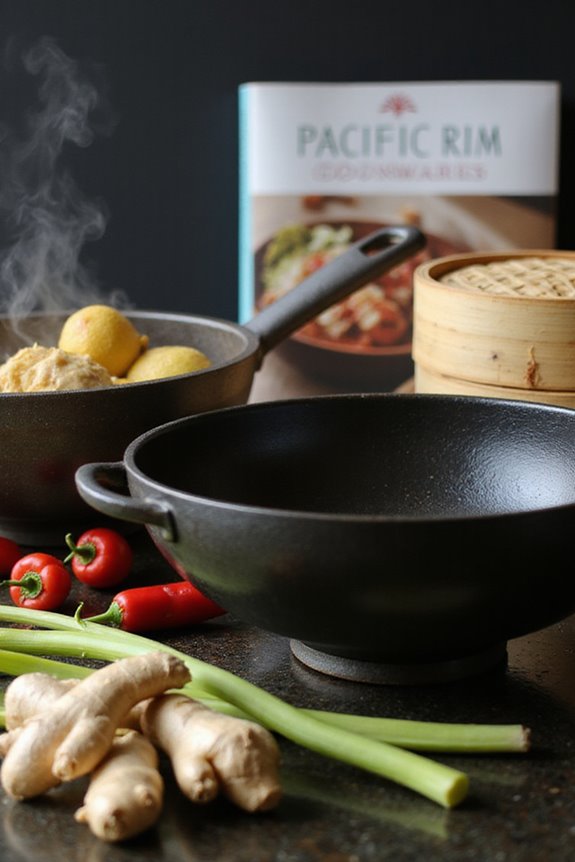
When choosing a Japanese cookbook, you should think about authenticity and variety in the recipes offered. Check whether the ingredients are easy to find or if substitutions are suggested, along with the skill level required for each dish. Additionally, consider how well the book presents visuals and cultural insights to enhance your cooking experience.
Recipe Authenticity and Variety
Choosing the right Japanese cookbook involves more than just picking a pretty cover or a popular author; it’s vital to contemplate the authenticity and variety of recipes contained within. Look for cookbooks that highlight traditional recipes, utilizing authentic techniques to recreate genuine Japanese dishes at home. Make certain the book offers a variety of recipes, from regional specialties to izakaya favorites, alongside beloved staples like ramen and tempura. Step-by-step instructions and clear measurements are essential for making complex recipes accessible, no matter your skill level. Additionally, visual aids, such as photographs of finished dishes, can greatly enhance your cooking experience and help you present your culinary creations beautifully, guaranteeing both satisfaction and authenticity in your Japanese cooking journey.
Ingredient Accessibility and Substitutions
Ingredient accessibility plays an essential role in successfully creating authentic Japanese dishes at home, as understanding your local market can greatly impact your cooking experience. Many cookbooks, like “Japanese Soul Cooking,” make it easier by offering alternatives for hard-to-find ingredients. This flexibility means you can adapt recipes based on what’s available. “Japanese Cooking Made Simple” stresses familiarizing yourself with common flavorings to enhance your dishes effectively. For those concerned about measurements, “Simply Japanese” uses U.S. measurements, making it more accessible for non-expert cooks. If you’re a beginner, “Authentic Japanese Cookbook for Beginners” highlights easy-to-find staples like soy sauce and garlic, ensuring you can explore a variety of authentic recipes without stress.
Cooking Skill Level Requirements
Selecting a Japanese cookbook tailored to your cooking skill level can greatly impact your culinary journey. If you’re a beginner, consider titles like “Japanese Soul Cooking” or “Authentic Japanese Cookbook for Beginners,” which offer simple recipes with easy-to-find ingredients. “Japanese Cooking Made Simple” is another excellent choice, providing clear, step-by-step instructions that simplify complex dishes. For those with more experience, “Japan: The Cookbook” includes intricate recipes that challenge your skills. Alternatively, “Simply Japanese” caters to all levels, ensuring you can find something suitable, regardless of expertise. Look for cookbooks that use US measurements, like “Japanese Cooking Made Simple,” to help ease your cooking process and build confidence in your Japanese culinary adventures.
Visual Presentation and Photos
Visual presentation in Japanese cookbooks can markedly enhance your cooking experience. High-quality visuals not only provide a clear reference for plating but also illustrate techniques that can seem intimidating. If you’re a novice, photographs can demystify complex processes, making them more approachable. Additionally, stunning imagery aids in ingredient recognition, helping you identify those unique items essential for authentic recipes. You’ll find that cookbooks holding a balance between clarity in recipes and appealing visuals often receive better user satisfaction ratings. The visual appeal inspires you, keeps you engaged, and encourages trying more recipes. When choosing a cookbook, look for one that provides both beautiful photos and clear instructions, ensuring an enjoyable cooking journey from start to finish.
Cultural Insights and Techniques
When you’re looking to choose a Japanese cookbook, it’s essential to contemplate how well it covers the cultural insights and techniques vital to authentic cooking. A good cookbook not only offers recipes but also explains the intricate techniques, from precise knife skills to ingredient selection, that elevate each dish. Look for those that include backstories on beloved meals, like the history of ramen and regional tempura variations. The focus on mindfulness in cooking is significant; cooking with intention leads to better flavors. Additionally, understanding the role of fermented items and seaweed enhances authenticity. Seasonal ingredients and local specialties should be highlighted, encouraging you to be creative with substitutions when necessary.
Meal Pairing Suggestions
Finding the right Japanese cookbook involves more than just checking off recipes; it’s about enhancing your culinary experience through thoughtful meal pairings. Look for cookbooks that offer pairing suggestions to create balanced and complementary dishes, allowing flavors to shine. A great resource provides guidance on pairing side dishes like tsukemono (pickles) or miso soup with main courses, ensuring every bite feels intentional. Consider seasonal pairings to utilize fresh ingredients and celebrate the shifting seasons in your cooking. Additionally, pay attention to regional specialties, as these often come with unique meal pairings that reflect local traditions. With these factors in mind, you’ll elevate your Japanese cooking to new heights, delighting both yourself and those you share the meal with.
Frequently Asked Questions
What Ingredients Are Essential for Japanese Cooking?
To create authentic Japanese dishes, you’ll need a few essential ingredients. Start with soy sauce, which adds depth to many meals. Then, stock up on miso paste for soups and marinades. Rice vinegar is vital for pickling and dressings, while dashi, a broth made from seaweed and fish, enhances flavor. Don’t forget sesame oil for cooking and finishing touches. Finally, keep fresh vegetables like daikon and scallions handy for balanced dishes.
How Can I Adapt Recipes for Dietary Restrictions?
To adapt recipes for dietary restrictions, start by identifying the key ingredients that need replacement. If you’re gluten-free, substitute soy sauce with tamari or coconut aminos. For dairy allergies, use plant-based milks or oils instead of dairy products. When reducing sugar, consider using natural sweeteners like stevia. Always taste and adjust seasonings as you go, ensuring your dish maintains flavor and authenticity, even with these modifications. Keep experimenting until you find the right balance.
Are There Specific Cooking Techniques Unique to Japanese Cuisine?
You might think cooking techniques in Japanese cuisine are just about sushi and ramen, but there’s so much more. You’ll explore methods like tataki, which sears meat quickly, and nimono, a simmering technique that melds flavors beautifully. Don’t overlook grilling with the binchotan charcoal, which adds unique smokiness. Mastering these techniques not only enhances your dishes, but it also deepens your appreciation for Japanese culture and its culinary artistry.
Where Can I Find Specialty Japanese Ingredients?
To find specialty Japanese ingredients, you can visit local Asian markets or specialty grocery stores. Many of these shops offer a variety of items like miso, soy sauce, and rice noodles. You can also explore online retailers such as Amazon or dedicated Japanese food sites for harder-to-find ingredients. Don’t forget to check local farmers’ markets, where you might discover fresh produce and specialty items from local suppliers.
Can I Use Substitutions for Traditional Japanese Ingredients?
Yes, you can definitely use substitutions for traditional Japanese ingredients, but be mindful of the flavor differences. For example, if you can’t find miso, tahini can work in some dishes. When you’re out of sake, try using dry white wine or a mixture of water and rice vinegar. While these swaps can help you create a similar taste, they might not capture the exact authenticity, so experiment to find what works best for your recipe.




